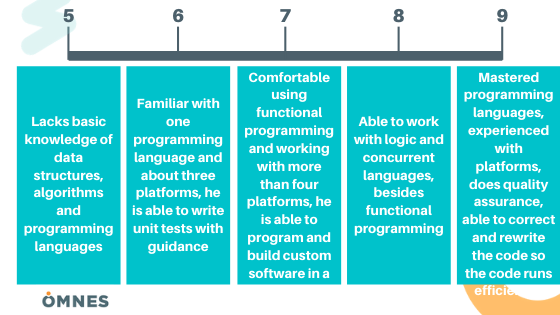Are you a manager of a large company looking for a way to make it even better and more successful? Do you want to understand positions beneath you better? Maybe you could learn a little bit more about your employees, while helping them acknowledge their mistakes, so they can work on them, and improve? Have you ever heard of BARS? It’s exactly what you are looking for! It’s perfect for IT recruiters with no technical background.
Table of contents:
What is BARS?
The behaviourally anchored rating scale, also known as BARS is a scale that measures the performance of new employees or trainees while following well thought out and specific behavioral patterns. Those patterns are used to rate every single employee individually. The behaviourally anchored rating scale is an important element of every structured interview. It brings benefits of narratives, quantified ratings, and critical incidents, as well as both qualitative and quantitative data. It was designed with the intention of reducing rating errors that usually occur when dealing with conventional rating scales.
How is BARS measured?
Behaviourally anchored employee appraisal process is usually designed in the form of a vertical scale with scale points ranging from number five to number nine, and according to that, it gives examples of poor, moderate and good performance.
The first thing that you have to do is understand and acknowledge all the essential tasks that an employee on a certain position in an organization has to do, along with the behaviours that follow those tasks.
Then, behaviors are rated for each employee, and then, as a result, you create a rating scale for each task by associating behaviors with grades (from five to nine).
This appraisal is developed by using the critical incident technique (CIT). The behavior examples are usually collected using the mentioned technique because it helps employers gain knowledge of how they can improve the employees’ performance.
This rating method is highly individualized, which gives more objective feedback – behaviors are rated uniquely for every single employee on a specific position in an organization, unlike basic rating scales that give you a more subjective rating and are applied in the same way to any position in the company, no matter how big the company is or how many employees it has. The behaviourally anchored rating scale was created as a result of dissatisfaction with the way that traditional rating scales (for example, graphic rating scales) judge employees’ performance. The biggest drawback when it comes to traditional rating scales, which caused dissatisfaction, was their subjectivity.
Just like any method, BARS has it’s many useful and positive benefits, but this approach is far from being perfect, so you should keep in mind that there are some downsides to this way of rating performance.
Pros of BARS
1. If planned correctly, it’s easy to use.
Employees are rated by standards that are very clear and easy for both them and the managers to understand and apply. Every grade has a very detailed, narrative example which makes it even less confusing.
2. It is impartial.
This employee appraisal process is focused entirely on behaviour, also it is objective and that is why it is considered to be fair and equitable.
3. It is behavioural based.
Like we mentioned, BARS is focused only on employees’ behavior and it makes both the employers and the employees understand what the job requires, what should be done and how it should be done. BARS gives clear performance expectations which, as a result, makes employees try harder to improve their performance and strive towards excellence.
4. It is individualised
BARS is designed as well as applied uniquely for every person and every job position in a company.
Now, here is a list of cons that should not be forgotten.
Before you implement a BARS system, analyze whether HR and management have the time available to support the plan. Also, consider does your organization has the existing skills to correctly define critical responsibilities, performance dimensions, and rating scales.
1. It is expensive and it takes a lot of time
Individualisation is a downside in this case. Imagine having a big, successful company with hundreds of employees- BARS is done for every person and every position in the company and that can take up a lot of time and valuable resources.
2. It requires a devoted manager
Managers must be motivated and highly involved, these appraisals require detailed information about employees.
3. You can miss the big picture.
Not all job expectations can be included in the appraisal, which creates some difficulties for the employer.
4. Success depends on the integrity of the managers.
As we had mentioned in the pros list, this kind of evaluation should not be biased, but there is still room for some people to question if it is.
5. Lack of discriminant validity between performance dimensions
6. Unreliability
Behaviourally Anchored Rating Scale Example
Let’s say that we want to apply the BARS method to a cashier’s job. The first thing we would need to do is try to think of everything a good cashier should do. Of course, there are some bare minimums that are expected to be done, and some additional behaviors that are not necessary, but are very much appreciated. That is how we will determine and create our rating scale- poor performance will be associated with the lowest grades; moderate performance will be associated with a little bit higher grades that will imply that the cashier can do the bare minimum tasks well; outstanding performance will be rewarded with the highest grades. Also, while thinking about how the narrative part of the rating scale will look like, remember that the grades usually range from five to nine so you can plan it out better.
Keeping that in mind, let’s try to design our own BARS so we can understand it better. For starters, let’s apply it to a cashier’s job:
5 – the cashier keeps making mistakes with money transactions, giving customers less change than they are supposed to receive
6 – the cashier constantly talks on the phone while serving customers
7 – the cashier writes daily reports of inventory and keeps track of money transactions
8 – the cashier helps customers with opening plastic bags and packing their groceries while suggesting alternatives to plastic bags such as recyclable linen bags
9 – the cashier gives a friendly greeting to the customers that have just arrived, giving them a smile and asking how their day went
So, how is this rating scale different from any other traditional rating scale, you ask. Let’s give our cashier another glance and see how our scale would be designed if we had used a traditional rating scale. Unlike individualized appraisals, there would be a universal question for all the employees, that would examine whether the employee, for example, “correctly handles money transactions’’ or “packs customers’ groceries’’ and the answer would usually look something like this: 5- always; 4- mostly; 3- sometimes; 2- almost never; 1- never.
Now that we have made this topic a little bit more clear, let’s try to apply this scale to a software developer’s job.

5 – the software developer lacks basic knowledge of data structures, algorithms and programming languages
6 – the software developer is familiar with one programming language and about three platforms, he is able to write unit tests with guidance
7 – the software developer is comfortable using functional programming and working with more than four platforms, he is able to program and build custom software in a timely manner
8 – the software developer is able to work with logic and concurrent languages, besides functional programming; he has experience with about 6 platforms; he builds his own custom framework
9 – the software developer has mastered programming languages and is experienced with platforms, he does quality assurance (QA) testing on existing software systems and is able to correct and rewrite the code until there are no more errors and the code runs efficiently.
The behaviourally anchored rating scale (BARS) is an excellent way of rating performance, and it can be used for all kinds of jobs! This process is expensive and takes a lot of time and effort to correctly carry out, so it is best suited for large companies that can afford it.
Like we mentioned, if you are embarking on this journey you will also need a team of invested and motivated managers that are willing to take on this kind of detailed work. But, when executed correctly, this method is great for both employees and managers, it is individualized, therefore they are able to acknowledge how they can work on themselves, improve and perfect their work.




